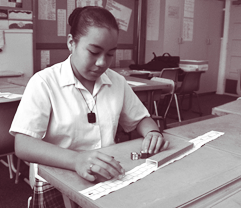|
The assessments
included eleven tasks which investigated students understandings, processes
and skills in the areas of mathematics called algebra and statistics.
Algebra involves patterns and relationship in mathematics in the real
world, the use of symbols, notation and graphs and  diagrams to represent
mathematical relationships and ideas, and the use of algebraic expressions
for solving problems. Statistics is concerned with the collection, organisation
and analysis of data, the estimation of probabilities and use of probabilities
for prediction. diagrams to represent
mathematical relationships and ideas, and the use of algebraic expressions
for solving problems. Statistics is concerned with the collection, organisation
and analysis of data, the estimation of probabilities and use of probabilities
for prediction.
One task was identical
for both year 4 and year 8. Six tasks had overlapping versions for year
4 and year 8 students, with some parts common to both levels. Two tasks
were attempted by year 8 students only, and two by year 4 only. Five
of eleven tasks have been selected as link tasks to be used again in
the year 2001, and therefore are not described in detail here. The other
tasks are released tasks for which full details are given.
The chapter presents
the assessment tasks in the following order:
-
The released
tasks attempted by both year 4 and year 8 students;
-
The released
tasks attempted separately by year 4 and year 8 students;
-
The five
tasks which will be used as link tasks.
Results show
that year 8 students were clearly more capable than year 4 students
in recognising and maintaining algebraic patterns and relationships,
but like year 4 students, struggled when fractional components had
to be considered. A high percentage of year 4 students could see patterns
and relationships that did not require too much calculation or understanding
of underlying processes. Surprisingly, only half of year 4 students
correctly used basic symbols of <, =, > to show relationships between
numbers. In a team task involving problem solving and logical thinking,
there was little difference between year 4 and year 8 in co-operative
strategy development. However, a larger percentage of year 8 teams
were more skilful in checking and refining their answers. On task components
common to both year levels, on average about 30 percent more year 8
students than year 4 students achieved success.
|